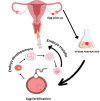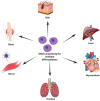Enhancing Endometrial Health in Assisted Reproductive Technology (ART): Evaluating Autologous Endometrial Cells and Platelets-Rich Plasma (PRP) via Hysteroscopic Injections
- PMID: 39114217
- PMCID: PMC11305442
- DOI: 10.7759/cureus.64068
Enhancing Endometrial Health in Assisted Reproductive Technology (ART): Evaluating Autologous Endometrial Cells and Platelets-Rich Plasma (PRP) via Hysteroscopic Injections
Abstract
This review article examines the effectiveness of incorporating autologous endometrial cells and platelet-rich plasma (PRP) through hysteroscopic injections within the field of assisted reproductive technology (ART). This study assesses the outcomes of these injections on the susceptibility of the endometrium, the dynamics of the uterus, and the frequencies of pregnancy in individuals with refractory thin endometrium. Based on a complete examination of several trials, it becomes apparent that autologous PRP injections provide encouraging turnouts in augmenting endometrial thickness, raising endometrial receptivity, and, in the end, raising chances of being pregnant and successful delivery. The research highlights the promise of autologous PRP and minimally changed endometrial cellular treatments in enhancing outcomes in ART, especially for people who have had problems with implantation. This article gives a whole evaluation of the medical use of and upgrades regarding the utilization of infusions of PRP and autologous endometrial cells under hysteroscopic control to deal with infertility issues related to endometrial health through the synthesis of contemporary studies.
Keywords: biomarkers; endometrial receptivity; endometrial volumetric analysis; infertility therapy; instillations.
Copyright © 2024, Karadbhajne et al.
Conflict of interest statement
Conflicts of interest: In compliance with the ICMJE uniform disclosure form, all authors declare the following: Payment/services info: All authors have declared that no financial support was received from any organization for the submitted work. Financial relationships: All authors have declared that they have no financial relationships at present or within the previous three years with any organizations that might have an interest in the submitted work. Other relationships: All authors have declared that there are no other relationships or activities that could appear to have influenced the submitted work.
Figures




Similar articles
-
The Effect of Autologous Platelet Rich Plasma on Endometrial Receptivity: A Narrative Review.Medicina (Kaunas). 2025 Jan 15;61(1):134. doi: 10.3390/medicina61010134. Medicina (Kaunas). 2025. PMID: 39859116 Free PMC article. Review.
-
Hysteroscopic injections of autologous endometrial cells and platelet-rich plasma in patients with thin endometrium: a pilot randomized study.Sci Rep. 2023 Jan 18;13(1):945. doi: 10.1038/s41598-023-27982-w. Sci Rep. 2023. PMID: 36653431 Free PMC article. Clinical Trial.
-
Use of Intra-uterine Injection of Platelet-rich Plasma (PRP) for Endometrial Receptivity and Thickness: a Literature Review of the Mechanisms of Action.Reprod Sci. 2021 Jun;28(6):1659-1670. doi: 10.1007/s43032-021-00579-2. Epub 2021 Apr 22. Reprod Sci. 2021. PMID: 33886116 Review.
-
Evaluating the Effectiveness of Platelet Rich Plasma Therapy in Enhancing Endometrial Receptivity for Women with Infertility: A Narrative Review.J Pharm Bioallied Sci. 2025 May;17(Suppl 1):S137-S140. doi: 10.4103/jpbs.jpbs_1876_24. Epub 2025 Apr 21. J Pharm Bioallied Sci. 2025. PMID: 40510957 Free PMC article. Review.
-
Impact of Hysteroscopic Instillation of Autologous Platelet-Rich Plasma on Pregnancy Outcomes in Patient With Recurrent Implantation Failure: A Case Report.Cureus. 2024 Sep 2;16(9):e68449. doi: 10.7759/cureus.68449. eCollection 2024 Sep. Cureus. 2024. PMID: 39360079 Free PMC article.
References
-
- Endometrial receptivity in the light of modern assisted reproductive technologies. Wallach EE, Yaron Y, Botchan A, Amit A, Peyser MR, David MP, Lessing JB. Fertil Steril. 1994;62:225–232. - PubMed
-
- What exactly is endometrial receptivity? Lessey BA, Young SL. Fertil Steril. 2019;111:611–617. - PubMed
-
- The clinical efficiency of transcriptome-based endometrial receptivity assessment (Tb-ERA) in Chinese patients with recurrent implantation failure (RIF): a study protocol for a prospective randomized controlled trial. Zhang WB, Li H, Lu X, et al. Contemp Clin Trials Commun. 2022;28:100928. - PMC - PubMed
Publication types
LinkOut - more resources
Full Text Sources
Research Materials
